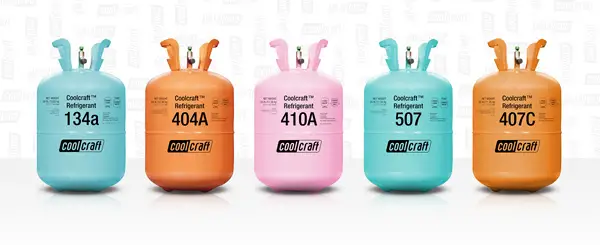Refrigerant cylinder, eh? Maybe you’ve heard the term, maybe you haven’t. Either way, we’re about to embark on a pretty cool journey (pun intended). Buckle up, because these cylinders are more fascinating than you might think, and understanding them could make a world of difference in your daily life, especially if you’re in a field that works with HVAC systems. So, are you ready?

Table of Contents
Understanding Refrigerant Cylinders
What is a Refrigerant Cylinder?
A refrigerant cylinder is a storage vessel designed to hold refrigerant gas or liquid. These tough cookies are made to withstand high pressure and severe temperature changes, providing a safe environment for these volatile substances.
Role in HVAC Systems
Ever thought about how your home stays cool in the summer or warm in winter? A part of the answer lies in refrigerant cylinders. They store the refrigerant used in your HVAC system, helping to transport heat and maintain a comfy temperature in your home or office.
Types of Refrigerants Stored
There are several types of refrigerants that could be in those cylinders, like R-22, R-134a, or R-410a. Each one has its own properties, and your HVAC system is designed to work with a specific type. Interesting, right?
Key Features of a Refrigerant Cylinder
Material Composition
Ever wondered what these cylinders are made of? Well, they’re typically constructed from high-strength steel or aluminum to handle the pressure of the stored refrigerant. Now you know why they’re so heavy!
Safety Features
Safety valves, pressure relief devices, color codes… refrigerant cylinders come with a whole suite of features designed to keep us safe. Because, let’s face it, you don’t want to mess around with these gases without some solid precautions in place.
Cylinder Size and Capacity
Cylinders come in different sizes and capacities, typically ranging from 30 to 1000 pounds. The size you need depends on your specific application. So, one size does not fit all in this case!
Using Refrigerant Cylinders
How to Use a Refrigerant Cylinder Safely
Pre-use Inspection
Before using a cylinder, you should inspect it for any damage. This is like the pre-flight checklist for pilots – it’s crucial for your safety!
Proper Handling Techniques
Handling these cylinders requires a bit of know-how. You should always keep them upright, never drop them, and avoid exposing them to extreme heat. Not too complicated, right?
Usage and Storage Environment
And where should you store these cylinders? In a cool, dry, well-ventilated place, far from flammable substances. Consider it their preferred vacation spot!
Loading and Unloading Refrigerants
Procedures for Loading Refrigerants
Loading refrigerants is a job for professionals. You need to use the correct equipment, follow the manufacturer’s instructions, and always, always wear protective gear. No exceptions!
Safe Unloading Practices
Unloading is just as important as loading, requiring similar precautions. It’s all about maintaining a safe environment for everyone around, including our lovely planet.
To read more in-depth articles on refrigerants: Articles on Refrigerants: The Ultimate Guide to Understanding Them
Maintenance and Inspection of Refrigerant Cylinders
Regular Maintenance Practices
Cleaning
Like anything else, these cylinders need a good clean now and then. Remove any dust or debris, keep them dry, and they’ll serve you well for years to come.
Checking for Leaks
Got a hunch there’s a leak? Use a soapy water solution to check. If you see bubbles, you’ve got a problem that needs fixing ASAP.
Inspections and Certifications
Routine Inspections
Just like cars, these cylinders need routine inspections. It’s all about ensuring they’re in tip-top shape and ready for action.
Necessary Certifications for Handling
If you’re handling these cylinders, you need the right certifications. It’s not just a piece of paper – it’s proof that you’ve got the skills to do the job safely and correctly.
Industry Standards for Inspection
The industry has set standards for cylinder inspection to ensure every cylinder meets the safety requirements. It’s like a report card for refrigerant cylinders.
Safety and Environmental Considerations
Safety Protocols for Handling Refrigerant Cylinders
Personal Protective Equipment (PPE)
You wouldn’t go into battle without armor, would you? Handling these cylinders is no different. Gloves, safety glasses, and protective clothing are your best friends here.
Dealing with Leaks and Spills
In case of a leak or spill, you need to act fast. Isolate the area, don proper PPE, and let the professionals handle the situation. It’s not the time for DIY solutions.
Emergency Procedures
And what if things go south? Having emergency procedures in place is crucial. Like a fire drill, but for refrigerant leaks. It could be a lifesaver!
Environmental Impact and Regulations
Environmental Concerns of Refrigerant Gases
Did you know some refrigerants contribute to global warming? Yep, they’re potent greenhouse gases. It’s why it’s essential to handle them responsibly and why regulations are in place.
Current Environmental Regulations
Our pals at the EPA and similar organizations worldwide have laid out rules for handling, storing, and disposing of refrigerants. And trust me, they’re worth following!
Disposal and Recycling of Refrigerant Cylinders
When a cylinder reaches the end of its life, it should be disposed of or recycled properly. It’s about taking care of our planet while we take care of our cooling and heating needs.
Conclusion: Importance of Proper Refrigerant Cylinder Handling and Maintenance
So, you see, understanding and handling refrigerant cylinders correctly is no small feat. It’s an essential task that helps us enjoy a comfortable temperature while taking care of Mother Earth. It’s a bit like being a superhero, don’t you think?